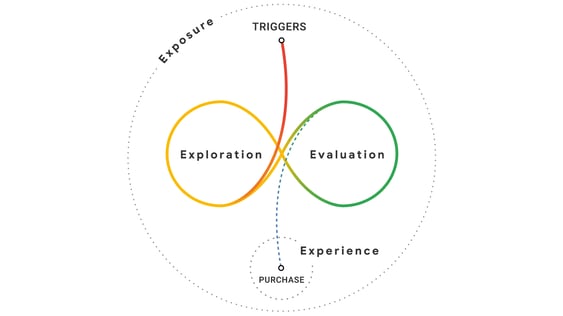As marketers, we're all too familiar with the “funnel”.
Originally introduced way back in 1898, it's evolved a few times over the last century, but for the most part, the marketing/sales funnel follows a consumer from their first point of awareness where they're introduced to a brand, all the way to their purchase/conversion—and the phases in between.
Introducing Google’s Messy Middle
It's exactly these phases in between that Google revisited in their latest report, Decoding Decisions: Making Sense of the Messy Middle. Their research applied behavioral science and discovered that in what they call the “messy middle”—the space between triggers/awareness and purchase—shoppers are using two mental modes: exploration and evaluation. And they're doing this across a variety of online resources, moving fluidly between these two states as they learn more about their options. Whether on a favorite blog, a social media site, a search engine, a review site, whatever sites shoppers visit, Google argues that they're either exploring or evaluating.

During the “messy middle” phase, when a customer saw just the name and logo of their second-favorite brand, it caused 25% of them to purchase from their second-favorite brand instead of their number one favorite brand.
Understanding Consumer Drivers for Massive Opportunity
As shoppers explore and evaluate, Google noted six cognitive biases that influence their purchase decisions:
- Category Heuristics: Short descriptions of key product specifications can simplify purchase decisions.
- Power of Now: The longer you have to wait for a product, the weaker the proposition becomes.
- Social Proof: Recommendations and reviews from others can be very persuasive.
- Scarcity Bias: As stock or availability of a product decreases, the more desirable it becomes.
- Authority Bias: Being swayed by an expert or trusted source.
- Power of Free: A free gift with a purchase, even if unrelated, can be a powerful motivator.
It was on these cognitive biases that Google formed their study of the “messy middle”. They asked 310,000 shoppers to identify their first and second favorite brands across a variety of categories. The biases were applied to advertisements to see how they would affect a change in preference from one brand to another. A third fictional brand was also included to test extreme scenarios.
Google found that up to 87% of consumers will switch to a competitor's brand at the sight of a single strong ad.
Applying these cognitive biases creates a massive opportunity for advertisers. There's power in just showing up, says Google. “Simply being present in moments of deliberation can be enough to win or retain consumer preference.” In this study, Google found that up to 87% of consumers will switch to a competitor's brand at the sight of a single strong ad.
Affiliate Publishers are Key in the Messy Middle
Affiliate marketers understand that being present in the customer journey allows brands to gain a competitive advantage and retain existing customers. And the more decision-making heuristics that you can apply, the stronger your chances. The affiliate channel offers endless opportunities to connect with and persuade consumers to choose your brand, and Google’s findings prove that simply being part of the journey is more important than focusing on where in the journey publishers fall.
But a diverse program allows you to address the cognitive biases in a more complete way. Working with as many publisher models as possible will provide a greater opportunity to connect with and showcase your brand. This not only allows you to retain or win customers but to increase AOVs as well—when multiple publishers are present in a customer journey, AOVs are up to 30% higher, according to network averages.
Across the CJ network, we see that the first interaction between a publisher and a customer happens (on average) eight days before the customer purchases. Affiliate publishers are clearly part of the “messy middle” exploration and evaluation phase—and are an obvious way to ensure your brand is present during that critical time.
Here are a few ways advertisers can learn from Google’s study and take full advantage of the “messy middle” in affiliate:
- Be present on all publisher sites—don’t allow customers to slip to their second-choice brand.
- Take advantage of competitor targeting and pay to shout louder than your competitors.
- Run placements to ensure you’re appearing when customers are considering competitors.
- Leverage third parties to spread positive messaging about your brand’s price and quality.
- Partner with publishers that can stop customers from leaving your site—and re-entering the “messy middle”. This includes cart abandonment and toolbar publishers—anyone who makes it easy for consumers to get the information they need without leaving your site.
While the funnel has evolved quite a bit over the years, one thing is for sure, if you aren’t there to help meet consumers' rapidly changing needs—another brand will. Add to this fact that the affiliate channel delivers 88% more revenue per shopper than other channels, which makes this performance-based channel a cost-effective and low-risk way for marketers to leverage in the messy middle.
Make sure to be present where it counts.

Share